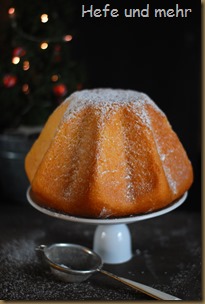
Since I tasted Pandoro many years ago I’m madly in love with this cake/bread. I love the light crumb, the flaky crust and its taste of vanilla and butter.
Until now I baked two different recipes: The Pandoro from the sisters simili which I found on Chili und Ciabatta and the recipe from the SFBI, which Susan published on Wild Yeast. The Pandoro of the Simili-Sisters is a yeast based one, with the butter laminated into the dough, while the SFBI-Recipe uses both sourdough and yeast and the butter is kneaded into the dough.
This year I dared to create my own recipe, with laminated butter for a crumb that can divided into long strands. It is risen with the pure power of a sweet starter. A sweet starter is a very mild sourdough which is shifted to the yeasty side by feeding it very often and keeping it on cosy 30°C. This let the yeast grow fast and so the dough can triple its volume in four hours! And this strength is needed to lift the butter and sugar loaded dough to a airy bread.
It is a really time consuming recipe: There are laying at least 75 hours between feeding the sourdough the first time to taking the finished loaves out of the oven. But when you taste this bread – which is really as soft and light as an cloud – you know that each second was spent well!
Pandoro
yields a big Pandoro of 650g and a small one of 400g
First dough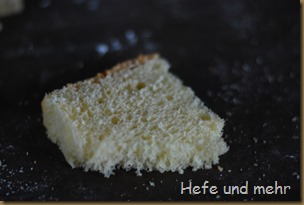
- 100g flour Type 550
- 35g Water
- 60g Egg
- 25g sugar
- 150g Sweet Starter, 4 hours after the last feeding
Second dough
- 60 g flour Type 550
- 25 g Egg
- 12 g sugar
- 3 g soft Butter
- all of the first dough
dough 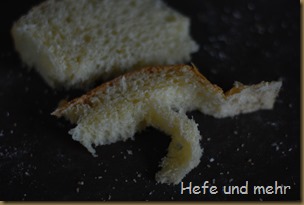
- all of the second dough
- 250g flour Type 550
- 5g Salt
- seeds of 1/2 vanilla bean
- 30g Butter
- 160g Egg
- 110 g sugar
Tourage
- 150g Butter
First dough: Mix all ingredients to form a homogenous dough. Ferment for 2 hours at 30°C.
Second dough: Mix first dough with the other ingredients for the third dough and ferment it for 3 hours at 30°C.
Final dough: In a stand mixer mix the third dough with flour, butter, salt and 86g egg and knead for 5 min at slow speed. The dough is very stiff at this time.
Now add 30g sugar and mix on slow speed for one minute.
Add 20g egg and mix in slow speed for one minute.
Add 20g sugar and continue mixing for one minute.
Add now egg and sugar like before until all sugar and egg is incorporated.
Continue mixing on medium speed until full gluten development (about 10 min).
Ferment for 1 hours, then transfer the dough into the fridge for one hour.
Now take the butter out of the fridge, flour it well and pat it with your rolling pin into a square of 17 cm lenght. Roll the dough into a squere with 26 cm length. Place the butter in the middle and fold the dough over like an evelope (see picture)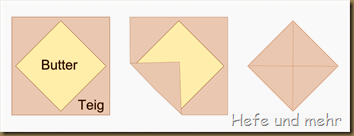 . Roll the dough into a band of 20 cm x 60 cm .
. Roll the dough into a band of 20 cm x 60 cm .
Fold the dough in thirds like a letter (single fold)and cool in the fridge for at 20-30 min, then roll it again into a band of 20 cm x 60 cm and repead the folding, resting and rolling for another two times.
Grease the pandoro pans.
Divide the dough it into a pieces of 650 g and 400g . Shape the dough into tight balls (without kneading!). Place the balls, seam side down, in the pans and proof for 12 – 20 hours until it reach the top of the pan (Proofing time depends on room temperature and strength of the starter).
Bake at 160°C for 45 min with steam.
Tips
- For weighting the eggs mix 5 eggs in the beginning and then weighting the amount of eggs needed from this mixture
- My Pandoro-Form is from Staedter. Don’t ask me why they call this a panettone form!
- To speed up the final proof, you can put the pandoros to 26°C (for example your oven, with lights turned on)
I sent this entry to Yeastspotting, Susans weekly showcase of yeast baked good.
Deutsch



Vielen Dank für das Rezept! Ich habe zwei Pandoros in. Kleineren/mittelgroßen Springformen gebacken – nicht so traditionell, aber Textur und Geschmack stimmen. 🤩💫
@Katharina: Hauptsache, es schmeckt 😀
Доброго времени суток! Я пишу на русском так как не знаю другой язык, но мне очень хочется оставить отзыв
.Пекла пандоро по вашему рецепту много раз ,это самый лучший рецепт .Я вам очень благодарна. Спасибо большое!!!
@ Екатерина: Thank you for your kind words!
Hallo, wahrscheinlich bin ich der millionste Leser der DIESE Frage stellt (bekomme ich dafür einen Preis? 😉 ), aber ich konnte die Antwort weder in den Fragen, noch woanders finden. : Wie hälst du die Temperaur für süßen Start und dergleichen (habe schon über Serverschränke, Microwellen und dergleichen gelesen, besitze dergleichen jedoch nicht) Vielen Dank und SCHÖNE, GESUNDE Weihnachsfeiertage )
Anait
@Aanit: Meine erster Starter ist in der Mikrowelle mit angelehnter Türe (und angeschalteter Beleuchtung) entstanden, mein aktueller Ofen beginnt bei 30°C und hält die Temperatur auch sehr gut.Und inzwischen habe ich eine Gärbox von Brod & Taylor, die ist dafür natürlich bestens geeignet. Man kann auch einen Backstein auf die Temperatur aufheizen und zusätzlich eine Schale mit heißem Wasser in den Ofen stellen oder die Heizung so runterregeln, dass darauf 30°C erreicht werden (habe ich auch schon gemacht, siehe hier).
Noch mehr Tipps hatte ich hier mal gesammelt.
Der Teig läuft mir gerade im Kühlschrank vom Teller 🙁
Ich glaube ich knete die Butter einfach unter und verteile dann den Teig in meine beiden Pandoro – Formen. Wäre das einen Versuch wert?
@Birgit: Das wäre das einzige, was mir dann noch einfallen würde…
Vielen Dank für die schnelle Antwort. Ich habe jetzt noch folgendes Problem: Mein Teig ist viel zu weich/flüssig. An was kann das liegen? Zu lange geknetet? Ich habe nach dem Einarbeiten von Zucker und Ei noch 10 Minuten auf 2. Stufe geknetet.
Jetzt ist der Teig so weich, dass ich große Schwierigkeiten mit dem Ausrollen des Teiges mit der Butterplatte habe. Ist da noch was zu retten?
@Birgit: Das klingt sehr nach überknetet – die Knetzeiten sind küchenmaschinen abhängig. Der Teig sollte am Ende dehnbar sein wie ein Strudelteig. Wenn nicht, dann ist er entweder zu lange oder zu kurz geknetet worden. 🙁 Ich würde den Teig nochmal für 2 Stunden in den Kühlschrank packen, manchmal stabilierst er sich dann wieder.
Ich würde gerne 1 Pandoro einfrieren. …ist das zu empfehlen? Und dann nach dem Auftauen nochmal kurz in den Ofen?
@Birgit: Ich würde den gefrorenen Pandoro für 15 min bei 180°C in den Ofen schieben und ihn dannach nochmal 1-2 Stunden ruhen lassen. Dann verteilt sich die Wärme gleichmässig und er schmeckt wie frisch!
Habe gerade mal nachgemessen: Es passen 3 Liter rein!
Hallo Stefanie, mein erster Versuch im Dezember ist gründlich schief gegangen, weil der Pandoro nicht aus der Form zu lösen war. Der gewaltsam herausgelöste Inhalt war aber so leicht und locker, dabei geschmacklich so exquisit, dass die Nutznießer meiner Backwaren lautstark einen neuen Versuch forderten. Und zwar JETZT nach dem Motto: Egal, nach Weihnachten ist vor Weihnachten! Das Ergebnis hat sich dank neuer Formen, die mir in weiser Voraussicht geschenkt wurden, auch völlig problemlos stürzen lassen. Optisch war es zwar wieder nicht der absolute Reißer, weil das Gebäck so locker-fluffig ist, dass es unter dem eigenen Gewicht in Schieflage geriet. Hätte die 750 Gramm Pandori vielleicht noch ein Weilchen länger in der Form belassen sollen, weil sie auch noch wenig Kruste entwickelt hatten. Außerdem waren die unteren Teigkugeln gut von den oberen unterscheiden, der Teig war nur teilweise zu einer Einheit verschmolzen. Aber der Geschmack und die Textur !! Nachdem ich jetzt hoffentlich alle Lektionen gelernt habe, kann Weihnachten kommen. Ich habe schon wieder Wünsche vorliegen nach dem Motto: Ist ja bald schon wieder Weihnachten…
Vielen Dank für das tolle Rezept !
Beste Grüße
Stefan
@Stefan: Das gute ist ja auch: Nach Weihnachten kommt Ostern 😉
@Birgit: Dann würde ich die Zutatenmengen im Rezept mal 1,8 nehmen, denn bei der Größe würde ich für jede Form 1 kg Teig veranschlagen.
Meine Pandoro – Formen sind ca. 16 cm hoch und haben einen Durchmesser von ca. 23 cm (weiteste Stelle). Das dürfte doch die richtige Größe für 650 g sein, oder?
@Birgit: Das ist unterschiedlich, je nachdem, wie steil die Form ist. Wieviel Liter passen denn da rein? In meine große Form für 650g-max.750g gehen etwa 2 Liter hinein.
Hallo Stefanie,
wie müsste ich die Zutaten verändern, um zwei große Pandoros zu bekommen?
Liebe Grüße
Birgit
@Birgit: Wie groß sollen denn deine Pandoros werden? Wenn du z.B. zwei Pandoro von 650g backen möchtest, musst du die Teigmenge entsprechend um ca. 20% erhöhen, d.h. alle Mengen mal 1,2 rechnen.
Could you please explain when goes 30g of butter in the final dough? Thank you!
@Janja: the butter is added directly to the final dough. I changed the recipe accordingly, thank you!
Pingback: Germknödel mit süßem Starter | Hefe und mehr
Danke für den geschenkten, wirklich herrlichen Sauerteig. Ihn im Gefäß zu halten war schon eine echte Herausforderung. Schade das man hier keine Fotos einstellen kann. Der Pandoro ist toll geworden. Einige der 8, in der Muffinform gebackenen Minipandoros, haben wir zum Frühstück gegessen. Einfach nur lecker!
@Mama:Hier ist dein toller Pandoro:
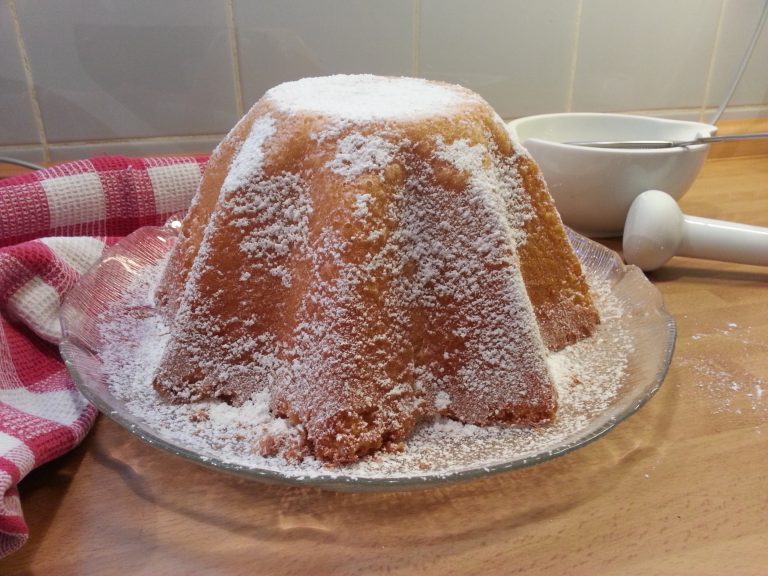
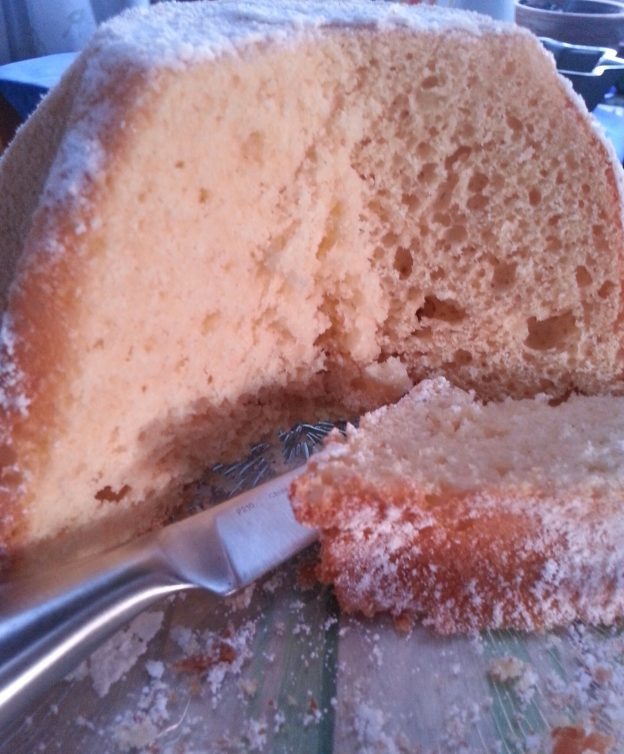
Danke, morgen essen wir zum Frühstück weiter. 🙂
@Mama: Das freut mich 😀 Wenn du mir ein Bild per Mail schickst, füge ich es dir ein!